|
Nissan Patrol
GU Top Mount
Intercoolers
ARE has gone too extremes to provide the very best
intercoolers possible !
There are 1000's $$$ & hundreds of hours spent in R&D on these
top mounts that no other company in Australia has done,
& because of this, there are none better - period. (as at
October 2009).
**Please note,
there are some big claims being made by a few companies, but
they can't supply proper back up test data. Talk is very quick &
easy, genuine real world R&D is time consuming & costly ! **
Data Logging Graphs of actual real world
driving efficiency gains
near bottom of this page

Pricing
ZD30
Direct Injection Nissan
Patrol.
|
$ 000.00 |
1.8% more
efficient |
Just take 15 minutes too tape the four
corner gaps closed in the top rubber seal. |
|
$ 598.00 |
11%
more efficient |
ARE Replacement. 500% stronger. Our Australian made
replacement recore with tanks TIG welded. Exchange |
|
$ 588.00 |
65%
more efficient* |
Our bolt on louvered 'Stealth' scoop. The 79% more even
air flow gives a big boost to the poor factory
intercooler. |
|
$ 588.00 |
68%
more efficient* |
Our bolt on louvered 'Aggressive' scoop. The 82%
more even air flow gives a big boost to the poor
factory intercooler |
| $
1058.00 |
52%
more efficient* |
ARE Performance Upgrade. Our special 68mm Australian made core &
our welded & reworked tanks. Exchange |
| $1586.00 |
83 or 85% more
efficient* |
'Stealth' scoop & Intercooler combination as above
$1526.00, or with 'Aggressive' scoop' 1556.00
Exchange. |
ZD30 CRD.
OE tank replacement & Mk 2 Sheet Metal Tank
Upgrade
|
$ 588.00 |
68%
more efficient
* |
Our bolt on louvered 'Stealth' scoop. The 81% more even
air flow gives a big boost to the poor factory
intercooler. |
|
$ 588.00 |
71%
more efficient
* |
Our bolt on louvered 'Aggressive' scoop. The 84% more even
air flow gives a big boost to the poor factory
intercooler. |
|
$ 696.00 |
10%
more efficient
* |
ARE Replacement. 500% stronger. Our Australian
made replacement recore with tanks TIG welded. Exchange |
|
$1298.00 |
58%
more efficient* |
ARE Performance Upgrade. 73mm Australian made core &
our own sheet metal tanks. No Exchange |
| $1796.00 |
87 or 89%
more efficient* |
'Stealth' Scoop & Intercooler combination as above
$1796.0 or with 'Aggressive' scoop' $1826.00
No Exchange. |
Mk2 Sheet Metal Tank Upgrade
-- RD28T and TD42T
This is the best we can supply
without going to a front mount !
|
$ 588.00 |
71%
more efficient
* |
Our bolt on louvered 'Stealth' scoop. The 82% more even
air flow gives a big boost to the poor factory
intercooler. |
|
$ 588.00 |
74%
more efficient
* |
Our bolt on louvered 'Aggressive' scoop. The 85% more even
air flow gives a big boost to the poor factory
intercooler. |
|
$1298.00 |
59%
more efficient* |
ARE Performance Upgrade. 73mm Australian made core &
our own sheet metal tanks. No Exchange |
| $1796.00 |
89 or
91%
more efficient* |
'Stealth' Scoop & Intercooler combination as above
$1796.00, or with 'Aggressive' scoop $1826.00.
No
Exchange |
We do not
sell front mount intercooler kits, because the performance
of our upgrade intercoolers when fitted with our scoop, is
very close to an average front mount (& better than some),
without the hassle of routing the pipe work & then the
chance of it rubbing, the extra throttle lag they cause, but
most importantly, drops the engine water temperature
slightly, whereas the average front mount increases the
engine water temperature approximately 7°c ! This is very
important to consider. An air/water system also raises the
engine water temperature, but not as much.
*
Note -
These figures are right. The
factory scoop delivers little air through the intercooler
which our engineered louvered bolt on scoop gives
84% more
ambient air.
The increased air
helps the inefficient factory intercooler more than our
efficient unit.
Unfortunately 100% heat
transference is impossible to achieve.
If you fit a larger
exhaust (quicker spool up) & as you raise the boost level,
our product will give an exponentially increasing gain over
the factory setup !
Following
is a whole bunch of technical information & data on one product
- Nissan top Mount intercoolers.
There are no better products when comparing apples to apples.
Straight bolt in. Trim rubber seal on 4.2 & plastic on 3.0L.
Complete 'Stealth' scoop with base & louvre -$588.00
or 'Aggressive' scoop
$588.00
All cores are made in Australia.
These products
are being stocked in Victoria by -
 |
194 Grange Road. Fairfield. 3078.
Victoria. Ph. (03) 9497 3899.
http://www.guest4wd.com.au |

Nissan
ZD30 Direct Injection Intercoolers
Our oe
replacement -
Much stronger
with a small performance/economy gain.
Our High Performance upgrade
-
Stronger with a
substantial performance gain.
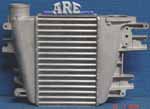 |
 |
 |
 |

|
 |
This is the
finished exchange unit you will receive. Note:
remove your steel pipe & pressure sensor to
refit to our unit. We supply 2 new o rings to
suit. Stronger, big increase in cooling with
less pressure drop.
$1058.00 incl. gst .
+ $200
exchange
fee refunded within 24hrs. of receiving
your assy. with reusable tanks |
These
measurements speak for themselves. You can see
the much thicker material in the PWR cores made
to our specs. Our header plates are 71% thicker
! Front face of the tube - header plate
joint is where 19 of the above 24 cores leaked. |
The tubes in the
cores we use are 869% thicker at front & back
faces & 318% thicker in entire side walls -
that's bloody strong. The other 5 of 24 leaks
were where the plastic cover rubbed the front
face of the tubes, on the 3.0L model. |
On any part of an
aluminium core we weld, we linish the cladding
as far away from the weld as we can, although
usually only a couple mm. on the underside, 5mm
outside - very important on header plates. |
The 3.0Ltanks require little
work too perform properly & much better than the
28 & 4.2,hence the $180 price difference between
them. There flow rate is excellent & our louvre
fixes their distribution problem. |
When I was young
a mate of mine was right into model planes& wing
profiles, but this profile comes from an article
I kept out of 'Circle Track' magazine on Sprint
car wings. It directs the air with minimum drag |
Nissan
ZD30 Common Rail Intercooler
Our High
performance
replacement -
Much stronger
with a performance/economy gain.
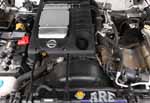
|
 |

|
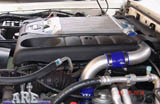 |
 |
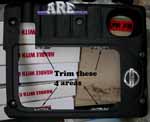 |
|
This is how the GU wagon came
into our workshop. It already has a Riken piggy
back & 3" exhaust fitted by Robert - Chapman
Dyno Tune @
Cooroy. |
After trimming the shroud,
the intercooler is a nice fit. |
Viewed from the R H side. |
Passengers side. The 51mm pipe is
not necessary, but gives a small gain in flow. |
Shroud has been trimmed & is
ready to fit. Only cutting that has to be done. |
The 4 areas that have to be cut
on the plastic engine shroud |
 |
 |
 |
 |
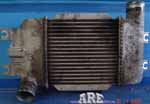 |
 |
|
Close up of the areas to be cut. |
The intercooler sits lower in the
frame, so we supply this shorter pipe to save
cutting the hose. The two bolts are to save the
oe pressure sensor bolts bottoming out on the
tank, & the oring is to seal the sensor |
This is the 2nd or 3rd leaker in
2009. we have had a gradual increase each year
since, but no where near the number of earlier
ZD30's. The frame is the reason for this. |
ARE upgrade top The core is
wider, longer & thicker. Slower air speed & in
longer, means much better cooling with less
pressure drop, double bonus. |
oe Nissan Bottom |
ARE upgrade bottom |
|
|
|
 |
Please check the quality of our
work. It is probably overkill for a 4x4, but all
jobs are the highest standard we can do,
regardless. |
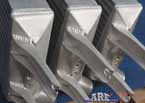 |
|
|
|
|
This shows the lines from the
rubber seal boot. Allot of wasted cooling volume
here. |
|
We fabricate these in batches of
three to 5 at a time |
|

Louvre blurred to hide it's exact
position, angle & shape |
 |
 |
 |
 |
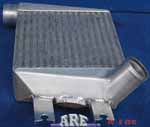 |
Showing the approximate position
of the important louvre inside the tank |
Close up of the blended radii to
smooth flow & more evenly distribute the charge
air across the core face. |
Difference in our inlet/outlet tanks, showing
our raised triangulated roof we use. |
Inlet/outlet tanks end on. |
Brackets & tanks are tacked
together for a trial fit mock up, in case we
miss measured ! |
Bottom front of the intercooler.
Outlet tank end |
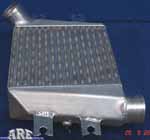 |
 |
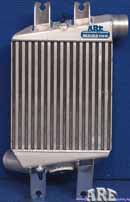 |

Testing the oe
Nissan intercooler before we start. |
 |
 |
|
Bottom back of the intercooler.
Inlet tank end |
Top front of the intercooler.
Outlet tank & boss for the factory pressure
sensor. |
Top of the intercooler. This is our first unit &
has 2 bosses fitted for our pressure data
logging sensors pick up. |
Temperature in/out & boost
pressure in/out probes for our MSE data logger.
We know exactly how good our products are! |
A Sunshine Coast customer
was kind enough to leave his vehicle with us for
4 days. |
Our core is 79% larger in volume
but unfortunately doesn't drop the temperature
by 79%, because of the deltaT factor- the closer
to ambient, the harder it is to remove the heat,averaging
just under a 60% gain in efficiency |
 This graph is a run as the
vehicle came to us - already fitted with our
scoop.
This graph is a run as the
vehicle came to us - already fitted with our
scoop. |
 This graph is a run after
fitting our sheet metal upgrade intercooler
- cooler day & in the rain. Intercooler more
efficient with 'a natural water spray'
evaporative cooling effect !
This graph is a run after
fitting our sheet metal upgrade intercooler
- cooler day & in the rain. Intercooler more
efficient with 'a natural water spray'
evaporative cooling effect ! |
 This graph is the third run
on the next day. A bit warmer & fine.
Intercooler not quite as efficient - by 2.4%
without the rain.
This graph is the third run
on the next day. A bit warmer & fine.
Intercooler not quite as efficient - by 2.4%
without the rain. |
Notes -
48.9%
efficient.
Factory approx.
36%efficient, a
gain of
36%
! Actual ambient temp was 25°c.
The run took 95sec
but I missed the start. Actual pressure drop
across oe factory core = 0.24 bar
(3.5psi).
|
70.5% efficient.A gain
of 96%
over factory! Actual ambient was 20°c
& it was raining. Run took 92 secs. but I
missed the start again. Actual pressure drop
was 0.9 bar (1.4psi). |
68.1%
efficient. A
gain of 89%
over factory. This is the figure too
use as comparison, not the 96% which
benefits from the rains evaporative cooling.
Run took 102 secs., but I had to wait longer
to turn around, car was
8 kph faster @ the top of the hill. |
Notes to go
with above 3 graphs
--
The
blue
area is
the difference between the temperature of the charge
air entering the intercooler, to the temperature of
the charge air leaving the intercooler. The larger
this difference is, the more torque, power & better
economy the engine will produce.
--
The
yellow
area is the difference between the pressure of the
charge air entering the intercooler, compared to the
pressure of the charge air exiting the intercooler
(pressure drop). The smaller this area, the better
the engine will perform as the turbo does not have
to work as hard (heating the air less) for the
engine to run at the same boost level. The ECU reads
the boost level from the outlet tank.
--
In the third graph, the charge air temp. out of the
intercooler starts off much hotter. This is because
I had just done 2 runs over the hill & the engine &
components were at normal running heat soak levels,
but once the vehicle was moving the larger scoop
quickly normalized the charge air outlet
temperature.

Nissan
TD42 & RB28 Upgrade Intercoolers
Our TD42 & RB28T
Mk2 Sheet Metal Tank Replacement -
no return & deposit
required
Check the
theory section below to see that compared to our
original upgrade, this
new Mk2
version takes that much extra heat out of the charge air
that it enters the engine at the same temperature if you
raise the boost from 10 to 17psi, or if you raise it
from 16 to 20 psi.
Nissan
GU Upgrade Scoops
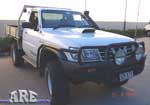
Aggressive Scoop |
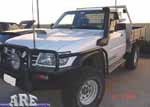
|
 |
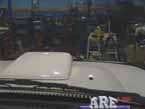 |
 |
 |
 |
| Our 'Aggressive' scoop sitting on
a customers GU ute. Yes, it is higher & more
aggressive looking, but this is to make the thing
work properly !Nissan have put the bonnet bulge in
the wrong place for air flow into the scoop & then
people add a bull bar & if they add the ultimate
'bad boy', the bonnet perspex (next column
please)- |
- deflector, then the
poor old oe scoop almost suffocates! Our scoop
suffers too, & I suggest trimming the section of the
top edge that is in line with the scoop.
It may look different, but you'll pick up approx.
1Litre/ 100klm. |
A comparison of our
scoop shell beside the oe unit. It is designed to catch
all the air that is deflected upwards by the bulge
in the bonnet. Yes, it looks more aggressive but it
works - air speed through the core is increased
79% !
The gain in efficiency
is 68% |
Eye level view out of the drivers
seat for a 5'10" driver. It is about half the
distance again above the center section of the bull
bar, so it is a very small restriction to the
immediate front forward vision, I'll say again
though, a very small restriction. |
This is the alloy base frame we
fabricate to attach the scoop too. It traps & forces
the proper ratio of air through the front section of
the core, & seals the rear section off, increasing
the scoop efficiency even more. 6mm studserts are
used - as oe, for straight bolt on fitment. |
There is well over two hours work for
us, just in this, but as I keep saying, the gain is
more than the upgrade intercooler gives. Power &
economy wise, I know it's extremely good value. |
The louver might not
look much, but after allot of R&D getting the size,
position & profile right, it makes a hell of a
difference to the intercooler cooling efficiency. |
 |
 |
 |
 |
|
|
|
| It may not look much,
but this will increase your factory intercooler
efficiency 68%
over the low factory plastic scoop. |
The louvre we weld
into the alloy base plays a big part in that
increase. It has the same effect as the louvre we
weld into the ic inlet tanks( see drawing in above
section), it forces the air much more evenly through
the core, getting the charge air that much cooler &
closer to ambient temperature. |
The louvre is very
prominent as it has to trap allot of air, otherwise
it rushes straight down to the back & tries to force
itself through the core. Without this, nearly 1/2
of the air goes through the back 1/4 of
the core |
This is the under side of the
completed scoop, as you buy it & ready to just bolt
on. Yes, some say it's not cheap, but it
gives 68% more efficient cooling with the
oe inter -cooler & even more on our upgrade. There
are hours of work making each one, so we believe it
is very good value ! |
|
|
|
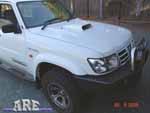
Stealth Scoop |
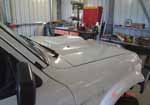 |
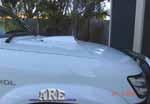 |
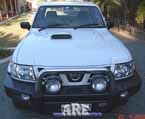 |
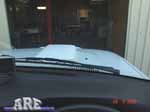 |
 |
 |
| This is our 'Stealth'
scoop. It will be available early November '09. We
have had feedback from several potential customers
that their wife would not let them buy our upgrade.
So we are tooling up for this one now |
We have laid the front lip back -
chopped off it's aggression - as much as the factory
bonnet bulge will allow us. If we cut it back any
more than this, we
exponentially loose efficiency, so this is our
limit. |
This has only
cost a 3% loss
in efficiency, so if it keeps the minister of
finance happy, we will live with it ! We have to
supply value or we're not interested in a sale. |
Looking
front on, the scoop appears nearly the same, but as
soon as you start moving side on, it's laid back
shape really does soften it's looks. |
From the drivers seat, this scoop
is a little less obtrusive, but neither 'block' much
of your forward view. |
Our Stealth scoop
uses the same base as our original aggressive scoop
so the louver can do it's important job.
|
The ARE upgrade is
only a little larger in frontal surface area, but
still requires the rubber sealing boot to be trimmed
on both sides, so there is no point in a bigger
core, the extra area will just become a heat soak.
We are as large as possible for a bolt on, |

The Theory
behind Our Nissan upgrade Ic's
|
I
don't know how I can stress enough how unique
& accurate our in house computer program is for
sizing intercoolers, we have been developing
and refining this program over ten years now. It
gives us an extremely detailed knowledge of
intercooling. |
From the 11 years of R&D & real world testing,
our computer programme tells us very closely how an intercooler
should work, which shortens our development time. Unfortunately,
there as some aspects that it can't tell us, the main one being
the ambient air flow through the ic. All models of vehicles vary
& then people add on their own accessories, some of which can
have a substantial bearing on the final result. In this case, we
have to take an educated guess until we get known data.
|
Legend |
A |
B |
C |
D |
E |
F |
G |
H |
I |
J |
K |
|
| Nissan |
3.0L |
3800 rpm |
16 psi |
420 cfm |
25°c |
124°c |
78°c |
10.8 kw |
617 btu |
84.6 kph |
0.0073
sec |
|
| ARE |
3.0L |
3800 rpm |
16 psi |
420 cfm |
25°c |
124°c |
42°c |
18.4 kw |
1047 btu |
58.7 kph |
0.0102
sec |
|
| ARE |
3.0L |
4100 rpm |
20 psi |
513 cfm |
25°c |
148°c |
52°c |
27.6 kw |
1571 btu |
63.3 kph |
0.0097
sec |
|
| |
|
|
|
|
|
|
|
|
|
|
|
|
| Nissan |
4.2L |
3900rpm |
10psi |
486cfm |
25°c |
118°c |
82°c |
9.8 kw |
559 btu |
143.1 kph |
0.0058 sec |
|
|
ARE |
4.2L |
3900rpm |
10psi |
486cfm |
25°c |
118°c |
44°c |
20.2 kw |
1148 btu |
96.4 kph |
0.0091 sec |
|
| ARE |
4.2L |
3900rpm |
16psi |
604cfm |
25°c |
142°c |
57°c |
28.8 kw |
1639 btu |
96.4 kph |
0.0091 sec |
|
| ARE Mk2 |
4.2L |
3900rpm |
16psi |
604cfm |
25°c |
145°c |
44°c |
36.6 kw |
2083 btu |
90.1 kph |
0.0112 sec |
|
| ARE Mk2 |
4.2L |
3900rpm |
20psi |
683cfm |
25°c |
154°c |
58°c |
42.9 kw |
2441 btu |
90.1 kph |
0.0112 sec |
|
Code & Details for above chart.
|
A |
Patrol engine capacity |
B |
Engine revs computer modeling
worked at, I believe maximum sustainable ! |
|
C |
Maximum boost pressure out of turbo used |
D |
cfm - cubic feet per minute of
charge air forced into engine |
|
E |
ambient temperature - outside air temp for
this calculation - only small effect. |
E |
Temperature of charge air out of
turbo. Least known of any data, but important |
|
G |
Temp. of air out of intercooler - more
efficient - more power - more economy |
H |
Amount of heat intercooler pulls
out of charge air measured in kilowatt/minute |
|
I |
Amount of heat ic. pulls out of charge air
measured in British Thermal Units |
J |
Speed of the charge air
traveling through the intercooler core |
|
K |
Time it takes a molecule of air to travel
through the core - bloody quick ! |
Legend |
Intercooler manufacturer |
|
M |
|
|
|
The 'Actual'
in our Nissan upgrade Intercoolers
 |
 Maybe
okay in Japans winter, but here , it just
really takes the top off the charge air
temperature. This wastes both
POWER &
ECONOMY ! Maybe
okay in Japans winter, but here , it just
really takes the top off the charge air
temperature. This wastes both
POWER &
ECONOMY !
|
 |
 |
 |
| This is the same flow bench I
have used for 15 years. It's had quite a few
switches & worn out a few motors, but Woody -Fataz
Engines( ex Bryant Engineering)-keeps it in tip top shape. |
The flow bench provided factual
back up to what I already knew - the stifling
limitations of a Patrol intercooler. Like a
Mazda rotary oil cooler, they are so small the
factory left clear passages without turbulators
(fins), too keep pressure drops acceptable.
Trouble is, hardly any cooling occurs in these
areas. Two wrongs make a big wrong in this case
! Our upgrade goes a fair way to fixing this |
This is how I found out exactly
how much charge air is by passing the internal
cooling fins. The 17.8% area allows 37.8% of the
charge air straight thru Without this the boost
pressure drop would cause a very noticeable loss
of power, but this causes less cooling of the
air - we've fixed both ! |
Dru made this tank (on the left)so I
could accurately test all
of the actual cores only.
It has a 3" outlet that
passes more than twice the air the core can
flow, without any pressure
drop at these sub 600
cfm figures. |
These are the worst 7 & by
far best 1 out of the 24 cores
we have replaced in 7 months of '09. I actually
picked about the third worst for testing, to
be fair & give results I can
back up by repeating at any time. |
 |
 ARE
tank mods ARE
tank mods |

|
 |
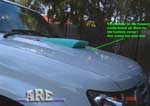 |
| I calculated the area
mathematically first, the laid graph paper over
the tracing, both very close. Our scoop is 270%
larger That's allot more forced air for better
cooling. |
This is not the position or
angle of the louvre, but it shows why our
intercoolers work as well as a much bigger unit
,because we utilize all of the core as evenly as
possible.
Turbulence is impossible to eliminate, only minimize |
This is a drawing of what the
charge air does in the tank. It is the tank in
the next pic. 1/2 the charge air is rushing
through the end 1/4 of the core !
*A |
These are Nissan 200sx intercooler tanks,
the oil residue clearly showing the air flow
pattern & turbulence inside the tank. I keep
saying, pressure drop & lag-no good. |
The scoop is a very
important part of our upgrade. Our ic is still not
as big as it could be, so it needs all the help it
can
get. Our ic is still a very substantial gain
over factory & 300% stronger in construction. |
|
*A |
Pressure drop rises & heat dissipation falls
exponentially to increased charge air speed
through the core. It is also exponentially
harder too cool the charge air the closer it is
too ambient, so the more even the air speed is
through the core, the more efficient it is In
this picture the air speed in the first few
tubes is approx .40kph, where as the air speed
through the end tubes is approx. 180kph, even
though the pressure is 12psi at the mouth of
every tube. In ARE cores with our louvers the
air speed only varies from approx. 95 to 125kph
- a huge difference ! |

The
Actual in our Nissan 4.2 Litre Intercooler & Scoop.
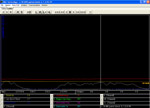
Ambient air speed through
core only.
As Nissan oe. except for turbo upgrade |
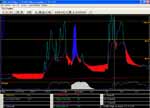
Air speed thru core, temps.
out of turbo
& into engine. Sealed 4 corner gaps in
rubber - with tape. |

Still oe intercooler, but
fitted ARE scoop
Air speed, charge air temps |
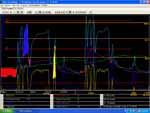
Next day, same set up, reran
with
the two boost sensors connected, but
no air speed thru core. |
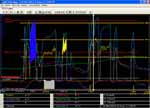
ARE intercooler & scoop
combination.
Air speed, temps & pressure drop. |
| 34%
EFFICIENT @ 60kph |
35.8%
EFFICIENT @ 60kph -
5%
more effcient |
44.7%
EFFICIENT @ 60 kph -
75%
more efficient |
45.6%
EFFICIENT @ 60 kph-
76%
more |
65.1% EFFICIENT@ 60kph Actual
gain of
91.5% in cooling efficiency. |
Being designed for race
cars, our
logger measures air speed in
meters / second, not kph. As a reference an
alloy crossover pipe
no intercooler is 1.1% efficient. |
Air takes the least path of resistance
& it loves escaping through the four
corner gaps in the oe seal. All we did
was run some masking tape around
each corner to seal them. |
Nothing is easy. A 270% larger
opening gave the oe. ic.59.3%
more air & it reduced the charge
air temperature by only %. This is
why accurate testing is needed,
some times "looks like it will work" is not good
enough & can actually be worse ! |
Cooler temperatures, no traffic,
driving the truck harder made
0.9% increase in efficiency. |
This is a minimum gain as a
customer who was getting an air/
water ic. fitted, graciously let me use
his truck for this logging & so I had to
rush & we ran out of time.
Jobs not done properly are listed in a
picture in the table below. |
Notes to go with
Graphs above.
All logs were made over two days in the same GU trayback
with a MR Turbo upgrade turbo, 10 psi boost, 3" exhaust, 35" mud
tyres.
Runs are as similar as traffic conditions would allow.
Accelerated to 60kph & sat pretty accurately on that.
Started logging, drove down driveway, turned right &
drove up the hill & down the other side, turned around
at the bottom & drove back over the hill & into the
driveway of our workshop.
Our Data Logger is an MSE (Motor Sport Electronics - 02
4648 0030) Technology unit that was mandatory by CAMS
for all GTP race cars to have fitted for scrutineers
monitoring purposes.
It is very fast & accurate & before you start studying
the graphs, have a look at the time line along the
bottom. These graphs are all less than 2 minutes long -
total !
The spikes are the gear changes
accelerating up the hill & then some stabs on the
throttle to maintain 60kph. This is how fast & accurate
our set up is.
Virtually, as you depress the throttle, the boost &
temperatures rise in unison, straightaway !
Also notice that as how intercooler efficiency
increases, the variance in the charge air temperature
into the engine decreases - being more stable - meaning
there is not as much expansion
& contraction of the metal components & so must increase
the life of the top half components of your engine by a
small amount.
Note that as standard the intercooler actually becomes
an interheater at times,
with the charge air out of the turbo being cooler than
the intercooler. The red difference at the start of the
runs is after warming the engine, backing out of the
workshop, then driving down the lane. Heat soak has
effected the ic & very slow to recover. This is not a
problem with our upgrade
intercooler & scoop combination as it's 91.5% @ 60kph
better efficiency is less effected & has so much higher
recovery rate.
You can see in the below graphs that travelling at
60kph in a standard Patrol, the Ambient air speed
through the core is 2.5m/sec or 8.9
kph.
You will note that with our scoop & the oe core the air
speed through the core rises too 4.67m/sec
(16.8kph), & the cooling efficiency goes up 11.6%.
Now with our upgrade intercooler & scoop, the
ambient air speed drops too 4.0m/sec (14kph.)
but the cooling efficiency goes up another 20.4% !!
This
is a total gain in cooling efficiency of
91.5%
!!
This
translates into noticeably more torque & horsepower, &
lower fuel economy, if driven sensibly. This
is where a big proportion of our R&D time & monetary costs went, balancing
core surface area, core thickness & core fin pitch, as
each time any of these
is increased too gain more cooling efficiency, ambient
air flow drops, causing a loss in cooling efficiency, so
it's a very complicated balancing act to get
the highest cooling efficiency possible for the Patrol,
without cutting up the bonnet.
Cooler Charge Air = more engine torque & power = better
fuel economy (if driven similar) !
In real world terms, the best example is a good
intercooler makes your vehicle drive on a hot day, like
on a cool night before installation.

The
effect of Fans on your intercooler performance
In fan testing we
conducted for Repco back in 2003, we got the
following results.
Their imported 10" ICE fan pulled 2.92m/sec or
10.5kph @ 382.8cfm. through a 56mm water core. Note
the actual dia. was 11".
A Davies Craig 10" fan pulled 3.31m/sec or 11.8 kph
@ 381.1cfm through the same 56mm water core.
To make this worse, a 16" Davies Craig fan rated @
2210cfm pulled 1822cfm through the same 56mm water
core, but only 1358cfm through a 55mm intercooler
core !
This means the air flow through a 10" fan will be
down around 8kph through your intercooler & 7kph
through ours, so it's slow speed slogging only,
the increase will
be a small gain, but at 100kph it will be a
small loss. This is an assumption, we have not
tested this yet.
Also note that from our
R&D testing,
if the fan
blade is around the wrong way & you just swap the
wire polarity, you will loose 32 - 39% air
flow ! In other words, if you buy
a puller fan & you can't turn the blade over, -
take it back or sell it, & buy a pusher, or vice
versa.
I will calculate the cfm. figures for air
speed though our intercooler cores & scoops very
soon & publish here - this will make the above
figures more relevant.
The above
paragraph was my 'guesstimation', table below is our
facts.
These are figures from testing on the
02/10/2009.
PDF here
| Nissan oe factory
Intercooler & Scoop @ 60kph |
Nissan Intercooler & ARE
Scoop @ 60kph |
ARE Scoop & Intercooler @ 60kph |
| Air speed through core =
2.64m/s, 9.5kph |
Air speed through core =
4.67m/s, 16.6cfm |
Air speed through core = 3.9m/s,
14.1cfm |
|
260.5cfm |
460.8cfm |
434.9cfm |
| Maradyne M093K-F 9" fan
Pull
Push |
Pull
Push |
Pull
Push |
|
4.49m/s - 16.2kph
3.79m/s - 13.6kph |
3.61m/s - 13.0kph
3.18m/s - 14.5kph |
3.61m/s - 13.0kph
3.18m/s - 14.5kph |
|
398.4cfm
336.3cfm |
319.5cfm
282.4cfm
|
319.5cfm
282.4cfm |
| But through the ic. =
358.2cfm
302.3cfm |
255.3cfm
225.6cfm |
254.3cfm
224.8cfm |
| From the above figures, a
noticeable gain will be achieved
with a fan under the factory scoop
pulling, & the scoop is so bad a
small gain will be realized
with a pusher on top. With the ARE
scoop, there may be a small gain
with a puller underneath, but a
definite loss with a pusher on top.
At 10 kph, a puller fan will make a
definite improvement in every case,
at 100 kph, a puller fan will help
the factory scoop but do very little with an ARE scoop.
Remember that a fan can't be fitted
under a TD42 ic. anyway, & I still
believe the restriction of the fan
on top, pushing, will only help
under 20kph. |
Now, a myth that
needs changing. On internet forums, it is very
common too read that little air goes into a Patrol
scoop & if the car has a bull bar,
no air goes into the scoop at 100kph.The first part
is right, in relation too the vehicle air speed,
only a small amount does go into the scoop &
through the core, BUT, at 100kph, more air is going
through than at 60 kph. Tests have been done with
rain drops & ribbons taped in front of the
scoop & why they have given a false 'picture' of
what is actually happening is because there is an
intercooler under the scoop. Reading above &
checking fan air flow testing in our R&D page, the
core presents quite a resistance too air flow, so it
only allows a percentage of the air that enters
an open scoop to flow through it. Once the scoop
cavity has filled with air (compressed too it's
limit), no more air can enter the scoop, so it flows
over the top of the scoop, which is why rain
droplets or pieces of ribbon, stand up & over the
top of the scoop, giving the appearance that no
air is going through the intercooler at all.
I know it's a
'toyota',
but the results will be similar to a Patrol. Note -
No Bullbar. No Wind deflector -
future test.
If you need full power at very slow
speed, I seriously suggest air/water intercooling.
If our intercoolers are too expensive for your
budget, I also suggest staying right
away from a 4" barrel, the air speed through these
is horrendous ! especially If you have done the
usual exhaust mods & upped the boost a little .Also, on most of the kits,
the pump
is too small, the hoses too small & the radiator too
small, so I guess they are close too suiting the 4" barrel anyway !
A 6" barrel, well that's a totally different
ball game !
ARE has air-water intercoolers that have been in
service for 10 years ( yes - we have had two weep
out of all the assy's we've sold). The
Frozen Boost intercoolers out of the USA
are made in China (as at this writing) & boy, I
can't wait to see them in 10 years time - we've
already had one in for repair, so good luck, being
bar& plate it was a throw away !

ARE has gone out on a limb here as the above are all actual
accurate results, & you will probably be told by some 'salesmen'
that our results
are pretty poor, theirs performs allot better, but if you've
read this far, I know you'll ask for their printed results. Talk
is very easy, & cheap !!!
|
Sorry - There
is no PERFECT Intercooler -
they all have
their drawbacks
!
The trick is to pick the best for your application and pocket !
As far as development time, effort & results
go, we have found the following.
Front Mount
intercooling is the easiest & happens to be the first we
developed way back in the mid '90's. Or tank shape is still
superior too most. Pipe work can be difficult. Definitely cause
lag to varying degrees.
Air/Water intercooling was next & is by far the
hardest to engineer for the ultimate results. The complexity &
componentry make it by far the most expensive. Unbeatable in low
speed applications. Radiator efficiency is it's archillies heel.
Dry Ice intercooling followed & is not much
harder than front mount, but very hard to tune & brutal in mid
range torque surge. Extremely limited in application - drag race
& dyno shootout only.
Top Mount intercooling development has taken most of
our R&D time over the past 14 months & now we have to try &
educate people to overcome the perception that it's just for
reducing the charge air temperature enough to appease both the
Manufacturers accountants & marketing people. The poor factory
stylists & engineers have to do the best they can within
restrictive company briefs. We are engineering top mount
intercooling too provide the maximum power, performance & engine
safety possible. The problems we were unable too satisfactorily
solve were cured after a mid year ('09) tour through the PWR
factory. They had not long received a shipment of their new
generation CAC tube extrusion & it looked good. Between talking
with their engineers & doing our own computer modelling &
testing, we came up with a core specification ( there are four
changes to cores made for us) that I'm assured by them is
exclusive too ARE (it better be, we pay a fair amount extra per
core for it), that has surpassed all the performance parameters
that I originally thought would be unachievable, actually
to the point of our upgrade top mount being a better all round
deal for a fair percentage of drivers, than a front mount.
Please note, I'm not saying all drivers, but street driven, tow
rigs, mid competition with some speed, mild to mid type power
upgrades, etc. Exaggerating ? check the charts & results below,
& you'll see the evidence to back this up.
Our testing to date has resulted in the following results :-
Factory top mounts, in most cases, are too small in size -
causing a higher pressure drop together with a less than
desirable temperature drop. Being too small means the charge air
travels too fast through the core (high pressure drop), & is not
in the core long enough for the hot air to be cooled for
performance. All they do is 'take the top' off the heated charge
air.
Factory top mounts are nearly always fed ambient
air from too small a scoop compounding there inefficiency. The
only good example I can think of is the late model Subaru WRX
sti version. The new Mazda 3 mps also look reasonably
good.
Factory top mounts are mostly made with minimal
material, both the thickness of the header plate, tube & fin
alloy, & with the later models, some with plastic tanks.
Please check our comparisons below too see just how unbelievably
thicker & stronger the Australian made cores are.
The latest Factory Top Mount trend of funnelling air from the
grille area, up through ducts under the bonnet can be the least
efficient of all. The Toyota Landcruiser twin turbo V8 diesel
has two ridiculously small intake vents in the upper grille area
too feed air to a reasonable sized intercooler. The grille is a
high pressure zone, but they are just, too small.
Fans fitted to the intercooler are an
increasing occurrence on the forums. Well, if it's on top of the
ic, it is decreases efficiency at any speed above a 15 kph &
really costs at 100kph ! If
it is under the intercooler, it will be of assistance until
approx. 30kph & then from approx. 40kph., it will be an
exponentially increasing hindrance & also cause loss of
efficiency. This relates to the oe scoop, the ARE scoop is still
effected but not as much because these so much more volume in
comparison to fan size For a touring vehicle, we don't believe
they are worthwhile. See
the test data at the bottom of this page for related fan R&D.
|
Please note. If you don't want to pay the $300.00 'tanks'
price which you will be out of pocket for approx. 6-7 days
depending on the freight, you can remove your assembly, send
it too
us, pay the appropriate price + return freight & we will
send your exchange unit within 48 hours. At present we only
have 3 of each of the 3.0 & 4.2 Litre units in stock,
but because the
cores are specially made too our specifications, we always
have at least 5 of each of them in stock.
If there is not enough
cooling for you here, please check our
'Shaker'
Intercooler page for larger units.
This page is also for people who have turboed a naturally
aspirated diesel & don't have the factory parts for exchange
- under development now !
| Tuners Please note - when you
run our upgrade up on the rollers, if possible
have the nose of the vehicle down - if a ramp is
used on a 4 wheel dyno, strap the vehicle down
on the front rollers only (if possible - not AWD
etc.) close the bonnet & angle the fan too
simulate driving on the road. Or else, raise the
fan too centre (yeh, I know it's a pain) on the
top of the grille height, otherwise, you will
not be tuning to the actual driving temps. |
I thank
you for reading all this & I hope you have learned more than
just 'something'
!

Currently A.R.E.
is spending considerable R&D time on developing
our own range of Alloy cooling products.
Check back for updates.

|
|